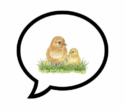Not everything will be a quick fix, unfortunately, but this guide will help you learn what to look for in your ill chicks and chickens so you can act fast and keep a healthy flock.
Disclaimer: I am not a vet, nor do I have a medical degree. All of this information is from my personal research and experience. Please do your own research alongside this blog as this is simply a guide.
Pasty Butt aka Sticky Bum
What is it?
This is when poop dries to the vent/butthole of your bird and keeps them from being able to poop.
Treatment
Depending on the severity you may either need to soak their butt in lukewarm water and gently try to work off the dried poop. Or, if there is just a little you can get a damp washcloth and gently remove it. Always make sure your chick is completely dry before returning to the other chicks.
Prevention
There are a couple ways to prevent this. Catching it early; if you see poop stuck to the feathers, remove as described above. Apple cider vinegar; adding a bit of apple cider vinegar to their water has been proven to prevent pasty butt. Cornstarch; sprinkling cornstarch over their food is a good way to prevent pasty butt.
Wobbly Chick Syndrome
What is it?
This is just when your chick is super weak, either from travel, malnutrition, or is being constantly stepped on by its brood mates.
Treatment
You can either isolate and make sure the chick is eating and drinking and watch to see if it gets better, or you can feed your chicks raw egg yolk. It’s full of the nutrients they need and its the same stuff they were thriving off of in the egg.
Depending on the severity of the weakness, you may need to isolate in regardless
Prevention
When you get your chicks, you can add vitamins and electrolytes into their water and/or give them the egg yolk.
Coccidiosis
What is it?
A parasitic infection causing diarrhea, weight loss, and lethargy.
Treatment
Medicate with Corid
Prevention
Give your chicks medicated food from the beginning. Corid is the medication in their feed.
There are also preventative doses on Corid packaging, which I suggest using on all of your chickens if even one shows signs of coccidiosis, because this is a rather fatal disease.
Lice & Mites
What is is?
External parasites that can cause irritation, feather damage, and disease transmission.
Attention!
Please keep in mind that too much diatomasceous earth can be harmful to chickens and that I do not suggest using it on every surface your chickens use. There are many chicken-safe insecticides, including citronella sprays, that you can make yourself. Add link here.
If you are worried about mites you can mix diatomaceous earth in with your bedding but wait for the dust to settle before allowing your chickens inside.
Treatment
If it is a minor infestation you can dust your chickens with Diatomaceous Earth, DE, and the mites should leave on their own. If it is a really bad infestation (your chickens feet scales are upturned instead of flat) then you can soak them in chicken safe insecticide solutions.
Prevention
When adding bedding into your coop, dust the floor with the DE to prevent the mites from getting into the coop. Out in the run and yard you can sprinkle the DE either throughout the entire run or just in their favorite dustbathing spots and they will spread it under their feathers themselves. Also, if you notice bugs getting into your chicken’s food or are afraid they will, you can mix some DE into the food. Yes, they can eat it.
